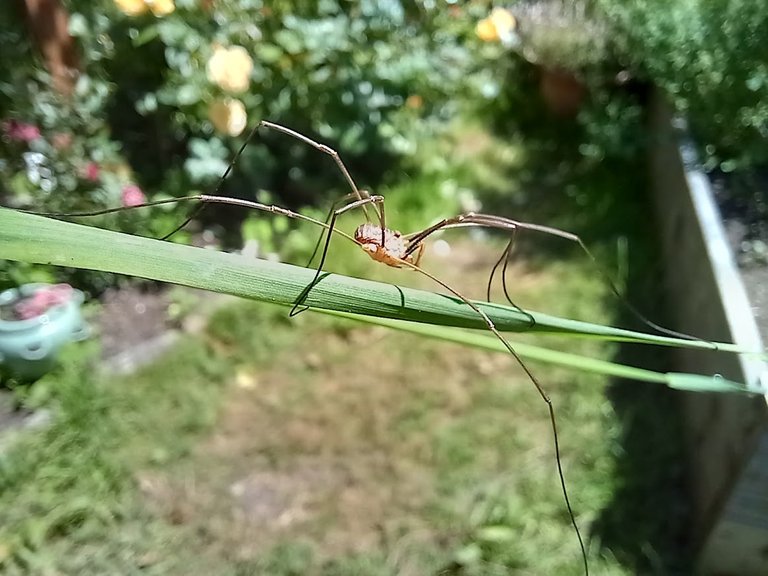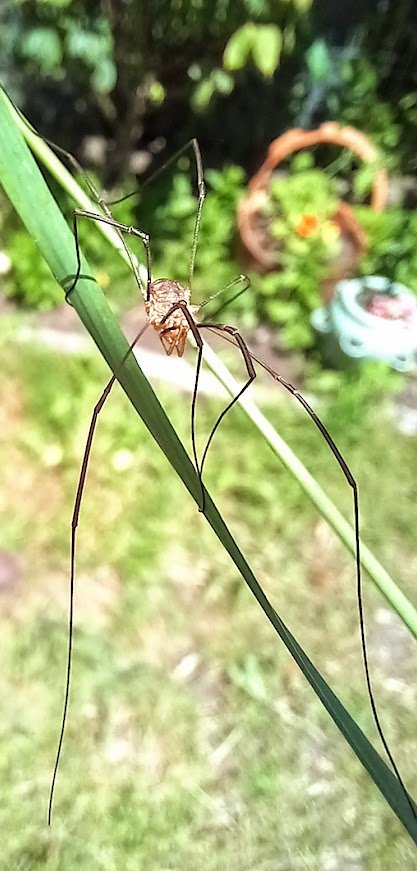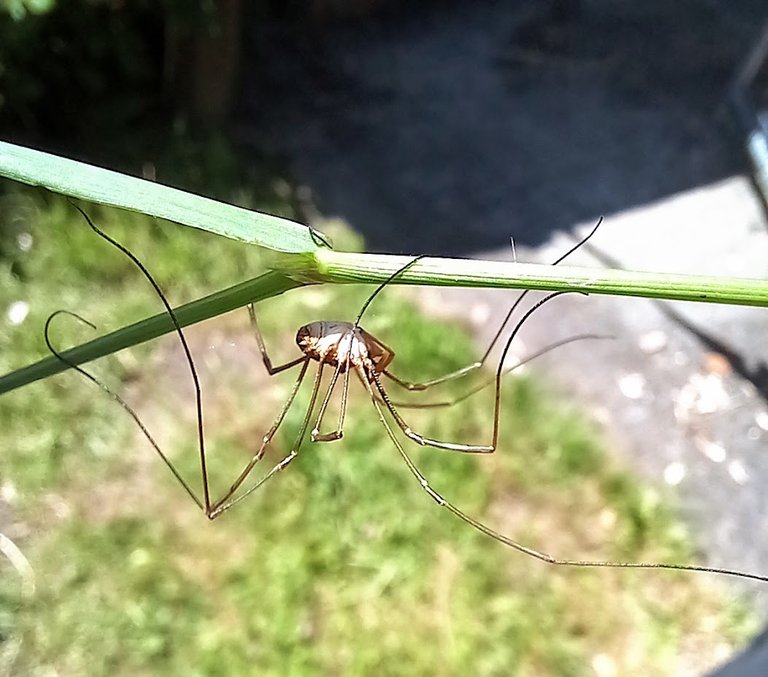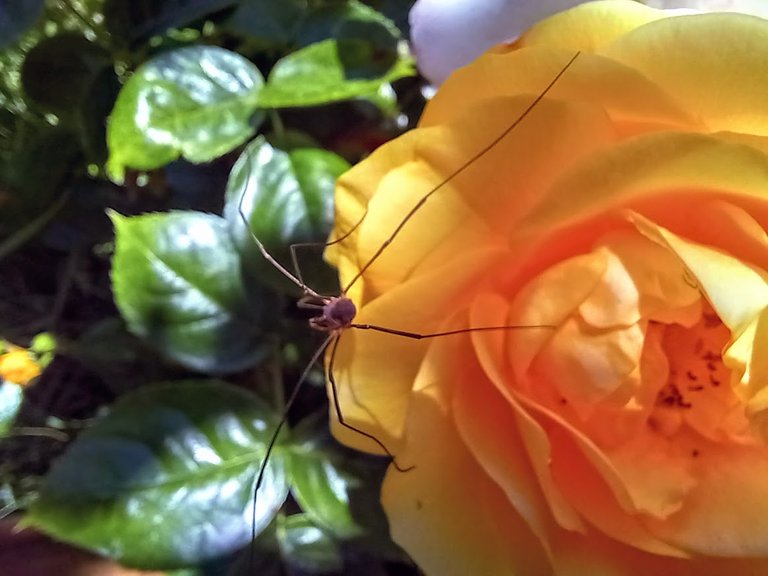So many half-written articles in my hopper about all sorts of things, and get me next to a bug? I'm running to my computer for information nearly immediately. I saw this beauty roaming around the roses earlier, and I became very excited. Finally, the time had come for me to debunk the myth.

For those of you who don't know what I'm referring to, there is a rumor that these long legged NOT ARACHNIDS are the most venomous creature known to mankind. Or something. I have wanted to know just how true that urban legend was, and where it came from. A long time ago I was told that they were incredibly toxic to humans, but because their jaws or mandibles were so tiny, they couldn't actually "bite" us. As a kid, I used to let them run up and down my hands and arms, until I heard that nonsense.
There was a fear then, that somehow, I'd find the one that could bite.

From time to time, I'd pick one up (before the new and deadly knowledge infiltrated my psyche) only to have it squirm away minus a leg. It always caused me such concern, even if I saw it lurking in the corner of the kitchen or wherever I first spotted it a day or two later. How could it survive without it's legs? Here's the kicker (pun intended), they will grow a new leg if it's not too old! How about that for resilience?! Their legs are incredible, because they smell, feel and sense changes in their environments, such as a breeze or a monster (like me) coming towards them! Here it is, hanging upside-down. It was so bright out, I hoped that the macro lens on my phone would catch some decent pictures. Luckily for us, it did!

Look at those legs! Phalangium opilio typically have two, possibly four eyes depending on the species. They will eat dead bugs, tiny living bugs (go get those aphids dude!) and some fungi or rotting plant matter. We don't mind that they want to live in our garden but they don't make webs either. If you see one in a web, try to save it if you can, it's probably going to be dinner for whatever made that web.
And those legs, omigosh. They can be up to three inches \ 7.62cm long!
As for that myth about their potential to be deadly, it appears that even though there are two misconceptions about the difference between Pholcidae and Opiliones. The latter not being a member of the arachnid family, I could sum it up by saying, "no worries", but if I was reading this, I'd want to know the full monty.
According to research at UC Riverside:
There is no reference to any pholcid spider biting a human and causing any detrimental reaction. If these spiders were indeed deadly but couldn't bite humans, then the only way we would know that they are toxic is by milking them and injecting the venom into humans. For a variety of reasons including Amnesty International and a humanitarian code of ethics, this research has never been done. Furthermore, there are no toxicological studies testing the lethality of pholcid venom on any mammalian system (this is usually done with mice). Therefore, no information is available on the likely toxic effects of their venom in humans, so the part of the myth about their being especially dangerous is just that: a myth. There is no scientific basis for the supposition that they are deadly and there is no reason to assume that it is true.
What about their fangs being too short to penetrate human skin? Pholcids do indeed have short fangs, which in arachnological terms is called "uncate" because they have a secondary tooth which meets the fang like the way the two grabbing parts of a pair of tongs come together. Brown recluse spiders similarly have uncate fang structure and they obviously are able to bite humans. There may be a difference in the musculature that houses the fang such that recluses have stronger muscles for penetration because they are hunting spiders needing to subdue wandering prey whereas pholcid spiders are able to wrap their prey and don't need as strong a musculature. So, again, the myth states as fact something about which there is no scientific basis.
So I let this guy go crawling through the roses again. Carefully though, especially because it was all grown up. No lost legs this time!

Thank you, so much, for reading and I always welcome your comments!
Take a look at @Labyrinths when you have a moment, and join our labyrinth community on HIVE if you're interested. We just started it, so there's not much going on yet, but if you're ever in the need for a "down to earth" (but not too earthy) psychic, you can find me online at Brigid's Aether.
Any images and graphics (unless noted) are mine.

Brilliant pictures.... I'm sure you got some difficulty by capturing this macro pictures...but this is beautiful...
Thank you so much! It's always such an adventure pulling the pics up on my computer and seeing if they actually "look" like something. LOL! 😁
Brilliant pictures! I never heard that myth, at least not growing up in Denmark... I remember them mostly being treated as beneficial creatures because they would eat mites and other tiny pests.
I still want to see one of these. Apparently my climate is wrong for them
We appreciate your work and your post has been manually curated on behalf of Insects Of The World Community. It will be added to the weekly curation report. Keep up the good work.
Interesting find, I also have some view in my area.
We appreciate your work and your post was manually curated by @none! from the DNA team!
Reach us on Discord to learn more about the project!
Incredible!, how can he walk with such long legs?. Thanks for sharing @cosmictriage.